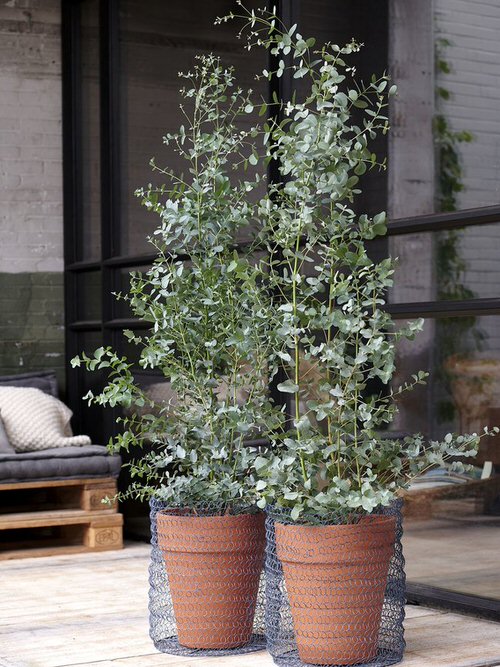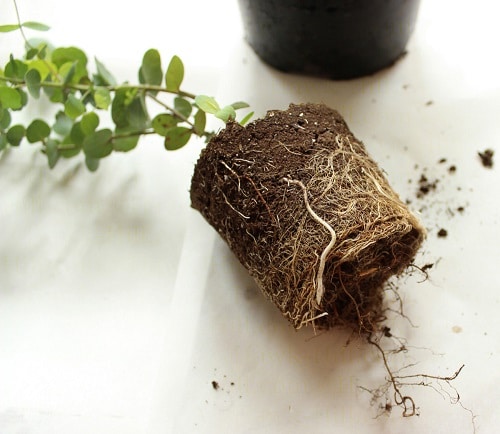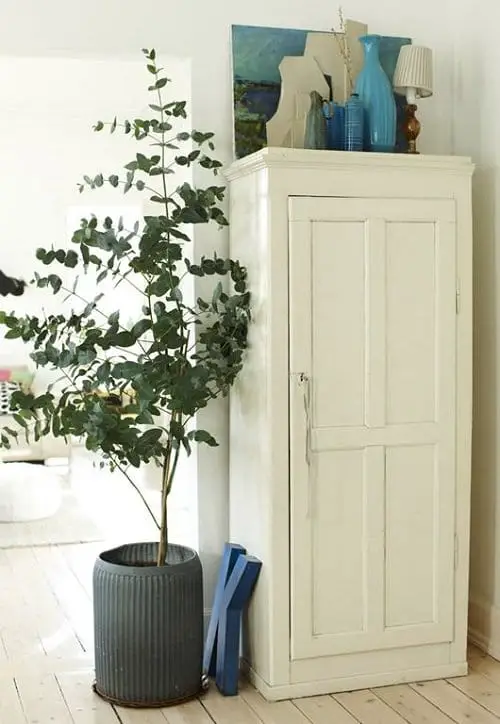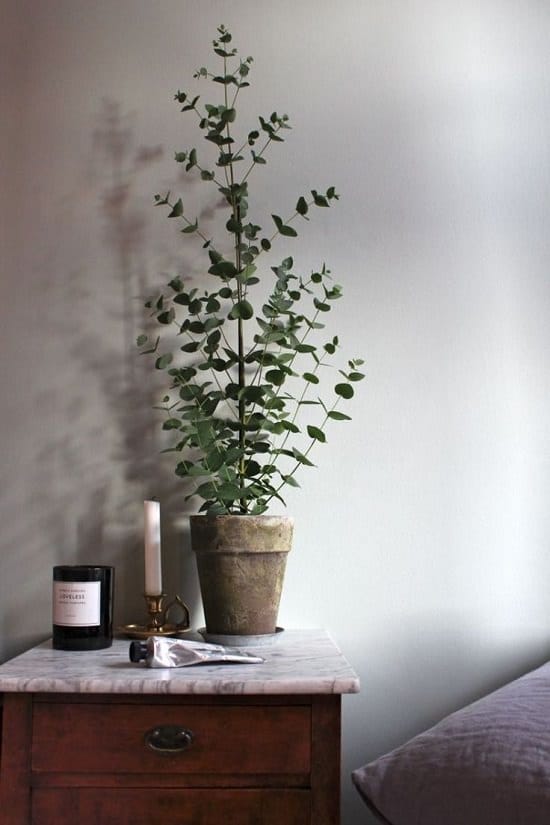With fragrant gray-green foliage and tall stature Growing Eucalyptus Indoors is rewarding–It also has medicinal benefits.

With its menthol-like fragrance and silver blue-green aromatic leaves, Eucalyptus makes for a great houseplant. If you want to add it to your houseplant collection, then here is everything you need to know about Growing Eucalyptus Indoors.
Check out our article on best smelling indoor plants here
Best Eucalyptus Varieties to Grow
While you can try and experiment with any variety but these are very large trees, and you’ll have to select indoor eucalyptus types carefully. Eucalyptus gunni is most appropriate for indoor growing because of its slow-growing habit and compact size.
You can also grow Tasmanian Blue Gum (Eucalyptus globulus) for 2-3 years in your home until it starts to grow rapidly. One more popular variety is Eucalyptus cinerea. Apart from these three, some others are listed below:
- Eucalyptus socialis
- Eucalyptus cinerea
- Eucalyptus vernicosa
- Eucalyptus erythronema
- Eucalyptus gregsoniana
- Eucalyptus coccifera
- Eucalyptus archeri
Propagating Eucalyptus
The best way to propagate the plant is by seeds. Get it from a local garden shop or buy online and sow multiple seeds in a pot filled with seed mix. Water well and cover the pot with a plastic sheet and place it in bright, indirect light. The seeds will germinate in 2-4 weeks and in about 5-6 months, the plant will grow 1-2 feet tall.
A Tip: Instead of propagating it from seeds, it is better to buy a healthy plant from a garden center.
Choosing a Pot
A young eucalyptus plant will thrive well in a pot size of 6-8 inches for a year or two. Afterward, you can re-pot it to one size bigger pot, according to the growth of the plant.
Requirements for Growing Eucalyptus Indoors
Location
Sadly the plant does not enjoy a low light location, which is why it’s not as popular as some other indoor plants. Proximity to the southern or western window or door is ideal for this plant, where it can receive plenty of direct and indirect sunlight.
Even if it receives morning sunlight and then indirect light during the day, it will grow happily.
Also, keep the plant safe from cold drafts or hot air by keeping it away from air vents.
Soil
The plant is not fussy when it comes to soil requirements and adapts to any type of soil. However, it’s best to use a well-draining and soil-less potting mix. You can also make your own soil with the help of recipes here.
Watering
Water the plant moderately to keep the moisture on the balanced side. Avoid too much watering, or it may promote root rot. It’s better to water only when the topsoil is dry to touch.
How to Care for Eucalyptus Indoors

Fertilizer
Eucalyptus has low fertilizer needs but to keep the plant healthy and thriving in pots, apply a balanced liquid fertilizer like 20-20-20 in half of the recommended strength every 7-8 weeks and avoid feeding in cold winters or when the plant is not actively growing.
Pruning
An indoor-grown eucalyptus tree needs to be pruned to keep the growth and shape in check, making it look more appealing. If you want to maintain a compact shape, you may have to prune the plant more often.
Repotting
Depending more on the variety your indoor eucalyptus may need once in a year repotting. You can shift it to one size bigger pot!
Pests & Diseases
The plant is relatively safe from pests and diseases, especially when grown indoors, which means you don’t have to worry much on this front while growing it as a houseplant.
Drying and Preserving Eucalyptus Leaves
You can take off the stem and hang it upside down to dry the leaves in shade. The leaves can also be kept on a paper towel. Wait till the leaves are crisp to touch. Once they are dry, store them in an airtight container.
Benefits and Uses of an Indoor Eucalyptus Plant
The leaves, bark, and roots contain the potent oil used in antiseptic and astringent applications. Eucalyptus oil is often used to treat respiratory ailments and mixed in cough drops and chest rubs:
- Eucalyptus has a distinct, menthol-like fragrance and is a popular herb for home remedies and air fresheners. The leaves can be dried and used to make a tea that has decongestant properties.
- You can also arrange the dried leaves in an attractive manner outside the patio. It’ll also help you to keep the uninvited bugs away.
- You can also use the leaves along with body scrub after crushing.
- The leaves also pair nicely with lemon, mint, and honey in a cup of tea.





I have a lofty sun room with a variety of plants in my home in Aspen CO. Not a good exterior for eucalyptus growth. Inside is different and it does well for me for 1-2 years of growth –then replanting. I harvest limbs are leaves for the scent or dried arrangements. It has great longevity and fragrance retention. When it reaches it’s final use days it adds a fragrance as a winter fireplace addition. Not a particularly beautiful house plant– but one that ads beauty in other ways from the fragrance – while growing and after harvesting. Free and easy to grow- but costly to buy in the retail after market.
I’m not sure why this article suggests using the leaves for tea? Ingesting EUCALYPTUS IS TOXIC to both humans and most animals!!!! (Maybe a kola bear wrote this article?).